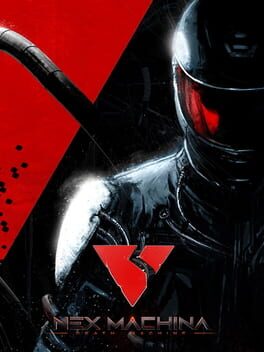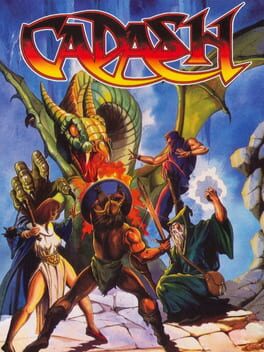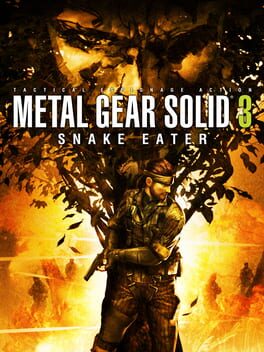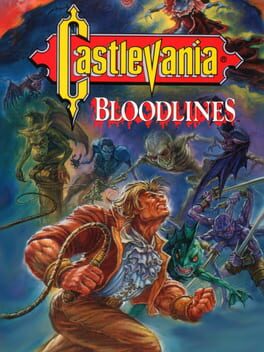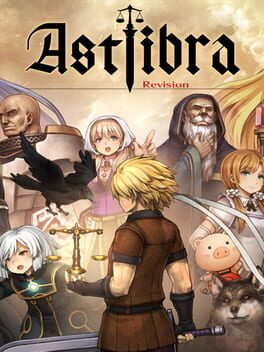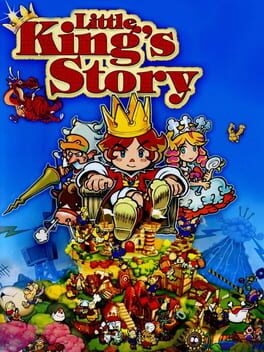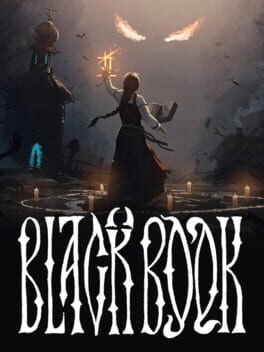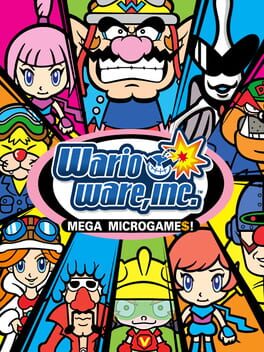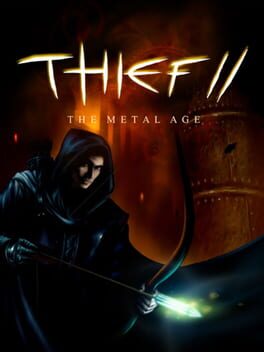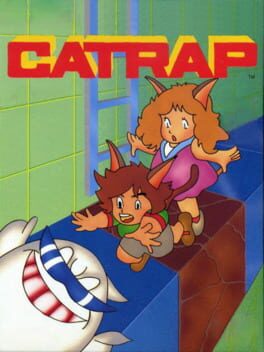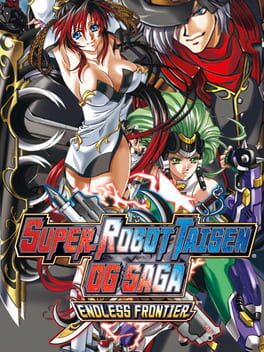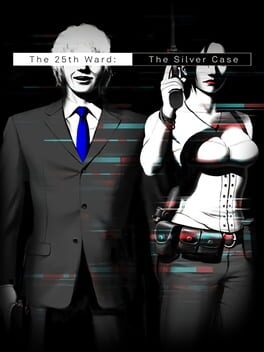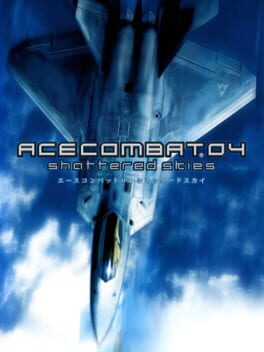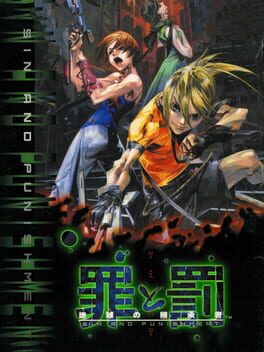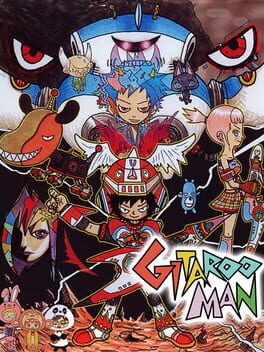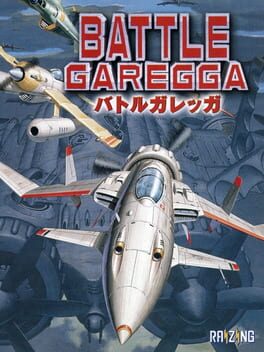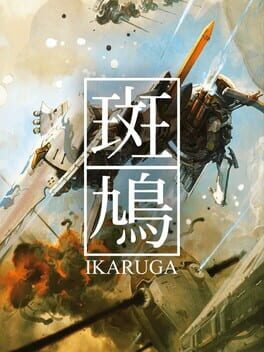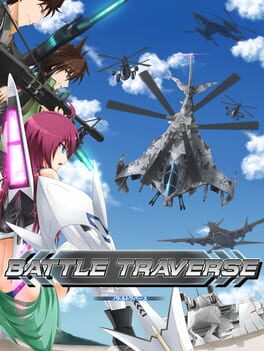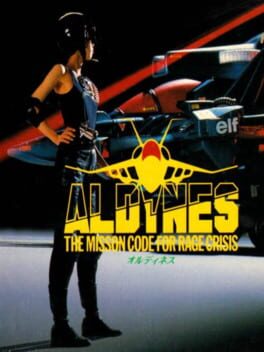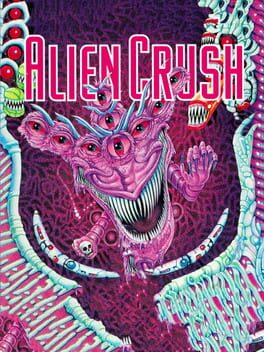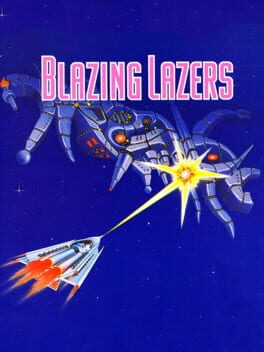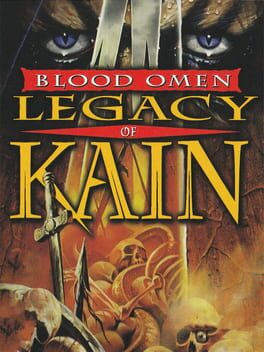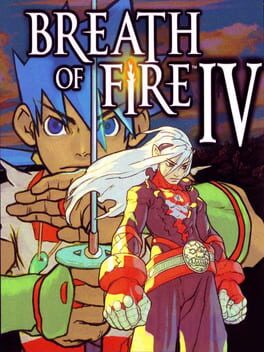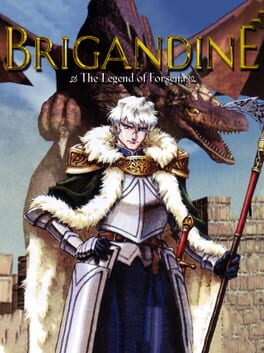zurrange
12 reviews liked by zurrange
Halley Wars
1989
I just did not realize there was an FDS version of this game due to the version label for this page being wrong as of writing this so I’m sorry folks, you’re getting a Game Gear review from me.
This one I was expecting to be pretty middling but this was a fun game with a massive flaw. You go through seven stages destroying any enemy in your way with bosses at the end. The gimmick here is any enemy that goes past you and touches the bottom of the screen does damage to the Earth. If it hits 100% then you get an instant game over regardless of your lives counter. This mechanic isn’t too hard to manage but I find the enemy placement by stage 6 gets a bit cheap and lame. There’s also some powerups you can get like the explosive pod which can shoot with you but can be used as a bomb.
You got a fun shmup with a neat concept that isn’t even too challenging so what’s the problem? It has the worst controls I’ve seen in a shmup. So get this, if you at any point go diagonally, you have to let go of the d-pad to start moving in a cardinal direction. Meaning if you hold up right, you can’t go just right till you let go as you’ll continue to go up right. I don’t get this and I even checked the FDS original and this wasn’t the case there. If you’re like me and have played a lot of these, this will screw with you the entire time. It’s a good thing the game isn’t too hard or I’d be furious but this alone sours my opinion on the game a little bit.
The difficulty like I said isn’t hard but the bosses are pretty easy too which is surprising, even the final one isn’t too bad. At least the aesthetic of the game will keep the game from being stale and even the music is pretty nice though to be fair, this is not an original GG game so I guess I shouldn’t be surprised.
I hate having to be so critical because I really wanna say it’s good but those controls are my number 1 issue. Someday I’ll play the FDS version and will probably leave a comment if I think it’s better or not. Maybe someone else could do it for me but I’m very doubtful that’ll happen. It’s still one of the better shmups on the handheld despite the issues. Still you’re probably better off playing one of the Aleste games.
This one I was expecting to be pretty middling but this was a fun game with a massive flaw. You go through seven stages destroying any enemy in your way with bosses at the end. The gimmick here is any enemy that goes past you and touches the bottom of the screen does damage to the Earth. If it hits 100% then you get an instant game over regardless of your lives counter. This mechanic isn’t too hard to manage but I find the enemy placement by stage 6 gets a bit cheap and lame. There’s also some powerups you can get like the explosive pod which can shoot with you but can be used as a bomb.
You got a fun shmup with a neat concept that isn’t even too challenging so what’s the problem? It has the worst controls I’ve seen in a shmup. So get this, if you at any point go diagonally, you have to let go of the d-pad to start moving in a cardinal direction. Meaning if you hold up right, you can’t go just right till you let go as you’ll continue to go up right. I don’t get this and I even checked the FDS original and this wasn’t the case there. If you’re like me and have played a lot of these, this will screw with you the entire time. It’s a good thing the game isn’t too hard or I’d be furious but this alone sours my opinion on the game a little bit.
The difficulty like I said isn’t hard but the bosses are pretty easy too which is surprising, even the final one isn’t too bad. At least the aesthetic of the game will keep the game from being stale and even the music is pretty nice though to be fair, this is not an original GG game so I guess I shouldn’t be surprised.
I hate having to be so critical because I really wanna say it’s good but those controls are my number 1 issue. Someday I’ll play the FDS version and will probably leave a comment if I think it’s better or not. Maybe someone else could do it for me but I’m very doubtful that’ll happen. It’s still one of the better shmups on the handheld despite the issues. Still you’re probably better off playing one of the Aleste games.
Nex Machina
2017
A supreme victory! Housemarque and twin-stick shooter genre pioneer Eugene Jarvis team up to create what might very well be the best twin-stick shooter to date.
One of Nex Machina’s strongest points is the immense variety in its room/enemy design. Rooms are not mere square boxes á la Robotron 2048, they can take on all kinds of shapes and paths of progression. This can range from winding linear stretches to ring formations, to dense rooms populated with (in)destructible geometry, to half-circles with enemies in the middle, to certain platforms being locked off until you destroy specific enemies, to the standard squares where enemies spawn all around you, to even a chase sequence where you’re being chased by a massive rolling boulder.
The variety in enemy design is just as amazing. Enemies can impede you directly or indirectly, by directly chasing/aiming towards you, aimlessly moving around the stage/covering the stage with bullets or lasers in a straight line or a sweep, and/or spawn bullets/enemies around them on death or kamikaze towards you. All archetypes can come in high-HP variants which demand more commitment to dispatch than others. Some turrets are invincible, which means that at times you just have to deal a sweeping laser across the entire stage. Then there’s all the enemy types related to scoring, which requires its own separate section to explain. Nex Machina makes all these enemies work by staggering enemy spawns behind intervals or certain triggers, while also pre-spawning in several enemies. This way the player has the breathing room to take in their surroundings and form a plan of action, but it also allows Nex Machina to recontextualize the same areas by simply spawning certain waves of enemies in certain positions.
While there might have been room for more complex stage hazards or enemies, one should consider that Nex Machina’s non-stop arcade pacing and “easy to pick-up” nature wouldn’t work as well with gameplay elements that aren’t immediately understandable. All new elements that Nex Machina does introduce rarely deviate from the basic “shoot everything to move on to the next area” setup. Sometimes your progress in an area is locked until you destroy a new enemy type (so you can get a better look at what it does), or they’re introduced gradually alongside previous elements in areas that lower the intensity a bit. Either way, both approaches allow beginning players to properly get eased into the systems, while returning players can simply speedrun through and remain engaged because of the scoring system.
Nex Machina’s core and stand-out mechanic has to be its dashing. These grant total invincibility, can be chained up to three times, let you shoot while dashing, and have a (relatively) noticeable recharge time once fully depleted. On this own this isn’t a terribly interesting system, but what makes it stand out is the Dash Explosion. Namely, each dash generates a small lasting explosion that can instagib any non-boss enemy and cancel any nearby projectiles. Enemies that will otherwise take a massive beating before going down can be deleted in a second if you simply dash into them. This is especially useful against enemies that spawn smaller enemies on death, since the lasting property of the explosion means that all its offspring and revenge bullets will also be immediately deleted. And even against bosses it remains useful by being able to dash in and out of bosses for extra damage. So dashing in Nex Machina has not just a defensive, but an offensive usage as well. Playing aggressive means phasing through bullets and enemies while one-shotting high-HP targets, and then getting out to safety as you spend your last dash charge.
While triple dashes + dash explosions make dashing immensely powerful, it remains balanced because of how crowded the stages can get with enemies, bullets, and lasers. The small AoE of the explosions means that dash explosions cannot reliably clear out entire crowds of popcorn enemies, and thus shouldn’t be used for that purpose. In larger rooms there can be a significant amount of distance between you and a high-priority target with bullets/enemies between, so spending several dashes just to gib that enemy can leave you in a terrible position with no leftover dashes and no hope of survival. Sweeping/aimed lasers, expanding energy circles, and dense bullet vomit regularly force you to dash at the right angles and moments, so you cannot always mindlessly spend all your dashes on offense. What’s more, in the later stages Nex Machina throws another curveball by having certain enemies fire distorted lasers, which cannot be dashed through at all! All these combined makes dashing a versatile yet situational tool that can be used creatively but must be used intelligently.
What makes Nex Machina really gel even across many replays is its highly optimizable scoring system. Each area not only keeps you occupied with a legion of baddies to shoot, but multiple layers of scoring objectives. The main one is ‘human chaining’, where you get more points the more humans you chain (a bonus which maxes out when having chained 20 humans). Here it’s not about grabbing all humans as fast as possible, but rather spacing out the rate at which you grab them so that your chain meter won’t go empty before you clear the area. This is then complicated by tankier enemy types that will try to capture your humans if left unattended for too long, making you prioritize either taking down those enemies or simply grabbing the humans right before they’re captured. The second major part of the scoring system is the multiplier, which multiplies the score you get from everything (Including humans) and is raised by killing enemies or finding multiplier tokens. Because the multiplier is global, you want to prioritize raising it and picking-up multiplier tokens where possible before picking up humans, which can be tricky given that your human chain meter depletes within six seconds. Some areas even come with pre-placed multiplier tokens (extra life spawns turn into multiplier tokens if you have the max. amount of extra lives, and some areas have ‘multiplier blocks’ which drop a token but can only be opened using a subweapon) which score-hungry players can risk prioritizing over all else. What’s more, each area gives you a Level End Dash bonus if you dash right before you get teleported to the next area. On its own, this may seem like a nifty and easy QTE to get some bonus points, but when you consider the context of trying to get the multiplier tokens and humans at the last possible second, where you are often dashing towards the last human before time runs out, cleanly clearing areas with a level end dash suddenly becomes a whole lot more complicated!
And then there’s all the secondary scoring objectives! Beacons are scoring targets placed near the edges of the screen, whose high base point value makes you want to delay destroying them as late as possible when your multiplier has been raised as much as possible. Visitors appear in the middle section of fights to move through the stage in a set path and drop a multiplier token when all of them are destroyed. Secret exits are hidden in some areas that require you to commit to shooting them either up close or with your subweapon, and upon being triggered will send you to a secret bonus area after clearing the current one. Disruptors are passive enemies that will try to run away from you of which only 4-5 can spawn per world and one per area, but the areas in which they spawn are randomly picked, with the intent to (as their name suggests) disrupt your precious route by introducing more chaos to the mix. Areas can also feature secret humans, which refill your chain meter by ~8 seconds rather than the standard 6, thus enabling more flexible chaining opportunities where you can grab the secret human first to get as many multiplier tokens as possible before the chain depletes or leaving the secret human for the last so you can enter the next stage with an overcharged human chain meter. You also receive a time clear bonus at the end of each world, so not only do you want to do all the above, but you also want to do it as fast as possible. And as for the micro-est of optimizations, destroying background objects also gives you tick points, so yet on top of all this again you want to cause as much background destruction as possible.
The result of all the above, combined with the existing legions of baddies coming at every direction, is gameplay where you are making a ludicrous number of micro-decisions per second. At any time and place there are multiple scoring objectives at different edges of the screen begging for your attention and enemies from every angle begging for your death. High-priority enemies that fill the screen with bullets are combined with high-priority enemies stealing your humans are combined with high-priority Disruptors/Invaders that are only on-screen for a limited amount of time are combined with secondary scoring targets that should be destroyed before the stage ends are combined with enemies that spawn revenge bullets/extra enemies on death are combined with an ever-depleting human chain meter that’s seconds short of running out. Replays of Nex Machina remain engaging because of just how intense and demanding it is, with almost no downtime to speak of. It’s pure and utter arcade.
What’s often the case with arcade games like these is that the spur-of-the-moment decision making they encourage eventually devolves into rote memorization as players try to beat 20-50 minutes of non-stop carnage more consistently, but Nex Machina remains chaotic to the point where improvisation is a more valuable skill to have. The way it accomplishes this is by combining highly volatile mechanics (i.e. mechanics where increasingly smaller differences in input create increasingly different outcomes) with minor (pseudo-)RNG-driven impulses in order to force a deviation in inputs, and so create unpredictability--or chaos for short.
Something similar was done in Ms. Pac-Man. While the original Pac-Man had a lot of volatility due to the way the ghosts would react to the slightest difference in movement, it was also 100% consistent, and the Ms. Pac-Man developers noticed how high-level Pac-Man play would revolve around executing the same ‘perfect’ route, thus largely doing away with the improvisation factor what drew most people in at lower and medium levels of play. To counteract this in Ms. Pac-Man, they had the ghosts move towards a random corner in the scatter phase at the start of each round, before resuming their standard non-random AI routines. This way, the player couldn’t solely rely on preset routes to survive but had to read and predict ghost behavior on the fly. It’s RNG, but it’s so minor that it’s only noticeable at higher levels of play. The minor RNG in Nex Machina serves the same purpose: making improvisation still relevant on higher levels of play, but without introducing too much inconsistency at any level of play. Of course, memorizing a strategy or a route still plays a large part when chasing high scores in Nex Machina, but it’s not all memorization, and that’s what helps keep it feeling fresh.
Nex Machina has volatility in spades. Because hordes of enemies and bullets moving towards you is a near-constant factor, the slightest deviation in inputs easily spirals out into unpredictable situations. The inaccurate nature of the twin-stick control scheme means that aiming or moving in the exact same directions each run is hard to consistently reproduce. The presence of long-term systems like the human chain meter and item bar means that micro-differences in input have future micro-consequences: entering an area with 25% chain meter left instead of 50% affects how long you can afford to delay grabbing humans or how much of a priority they are, which in turn affects future decisions and decisions after that. The item bar being filled by destroying enemies means that because of the massive and dense waves of enemies, you can only roughly predict where exactly an item will drop. Forgoing to kill optional enemies in turn makes it harder to memorize when said items might drop. Enemies that spawn bullets or smaller enemies on death add even more stuff on screen that makes things harder to control. On Master difficulty enemies will on death shoot revenge bullets towards you, thus making small deviation spiral out even more noticeably (in addition to enemy types that do on-death attacks on any difficulty), and both the player and the enemy move faster, increasing the pressure and making it more likely to make imperfect inputs. On Hero difficulty you must deal with even faster/denser revenge bullets and every power-up drop spawning an expanding laser circle, whose positions you can also only roughly predict.
Then there’s the little pockets of RNG. Some enemies move in random directions or have a slightly randomly offset spawn position, which combined with the way item drops work makes their spawns even harder to predict in advance. Humans don’t completely stand still but instead randomly and slowly roam about their spawn point, which then affects where human stealer-type enemies will go and which human they will prioritize, on top of you having to adjust your human chaining routes. Some enemy types begin bouncing or shooting in random directions or orientations on spawn. The most notable example of RNG are the Disruptors, whose placement and appearance are certainly randomly picked out of a handful of preset solutions.
What then prevents Nex Machina from feeling like uncontrollable chaotic nonsense is that the player has the tools to deal with everything consistently, and that Nex Machina does not demand absolute precision. The most notable example of this is how often Shield pick-ups are dropped (provided the player has all other item upgrades), which means that small one-off mistakes do not result in immediate death spirals. Similarly, the game is quite lenient with extra lives, which are completely divorced from scoring and can be found in secret spots, of which there are about 2-3 in each world. The human chain meter is also quite lenient in how fast it depletes (especially when compared to other chaining systems like those in the Dodonpachi series). Each area is designed to always have a close-by human near each starting point that you can always reach in time, provided you nail the level end dash of the previous area (which replenishes a bit of human chain meter when nailed). The triple dash gives you a lenient amount of i-frames to dash through bullets and enemies with, and recharges relatively fast. Subweapons allow you to dispatch multiple tankier enemies at once, and your primary shot with the spread upgrade is wide enough that aiming accurately isn’t that important. The RNG in Nex Machina does affect potential clear time and the potential end-of-world score bonus you get for clearing the world quickly, which might suck if you’re speedrunner. But thankfully, this score bonus always caps out at 4 minutes and 30 seconds. If you clear it under that time, you will get the highest possible score bonus, meaning that getting slightly subpar clear times (because of RNG) won’t be damning to your score. To conclude, even if some details are unpredictable or have random deviation, it’s well within your toolset to deal with them.
It's when you don’t have that toolset that Nex Machina feels like some straight bullshit, which the Single World mode nicely showcases. There you start each run in a world of choice without your upgrades--your triple dash, weapon spread, dash explosion and weapon range--leaving you only with a narrow peashooter and limited mobility. For the first world this is relatively doable since it’s designed around you starting naked, but in the later worlds (or starting the first world on higher difficulties) you are increasingly dependent on the random upgrade item order to give you the actually useful upgrades first (triple dash and weapon spread) because of how quickly things spiral. I often find myself having to restart a dozen times in the first world after making a small mistake that with all my upgrades either could have been avoided or compensated for.
Not all implementations of RNG in Nex Machina are ideal, of which the random upgrade item order is the most noticeable. Some upgrades are more helpful to the survival of your un-upgraded ass than others. Triple Dash and Weapon Spread, for example, make it much easier to control crowds than Weapon Range or Dash Explosion. Shields seem useful to have at first, but the other four upgrades are better at preventing you from being in a situation where you’re in danger of being hit to begin with. The upgrade order is completely out of the player’s control, and scoring/survival can deviate strongly because of that. For that reason, it would have helped if the upgrade order was static (where Triple Dash and Weapon Spread are preferably the first two), or if the player could control the upgrade order somehow, or if power-ups were styled a la Cho Ren Sha 68K/Crimzon Clover where it’s a spinning circle of all possible power-ups from which you can pick only one.
The chaos that Disruptors create is also not used as effectively as it could have been. If Disruptors spawn close enough when you teleport into a new area, then you can gib them in a second and deal with the rest of the enemies as usual, which makes Disruptors not disrupt much of anything. It then would have helped if Disruptors did not spawn immediately when the player enters a new area, and if Disruptors always spawned outside your range or behind other enemies, where it could then sow more chaos. It would have also helped if Disruptors could never spawn in the penultimate areas leading up to the boss fight of each world, which are intentionally always easy breezy to build up the boss fight coming after. Disruptors then spawning in those areas feels like RNGesus giving you a freebie, which is why they’re better off always spawning in the ‘real’ areas of each world.
Although the boss fights in Nex Machina are built up as the climax of a world, they ironically feel more like moments of rest compared to the intensity of regular gameplay. Human chaining and secondary scoring objectives cease playing a role during boss fights, so the only optimizations left are not getting hit and dealing as much damage as possible. The target prioritization and crowd control of regular gameplay barely play a role in boss fights, as bosses instead opt to throw bullet patterns at you. Combine the lack of scoring opportunities with the relaxed intensity, and you end up with boss fights in NM feeling like a lesser mode of gameplay. Arcade games with chaining systems do often relax scoring requirements during boss fights or slightly alter how it works for bosses only (since it’s hard to ‘chain’ a single enemy), but they make up for it by having the boss be more intense to fight. In Nex Machina, the only truly intense bosses are the TLB and the fifth boss; the former takes the kids’ gloves off the bullet pattern design and goes all out, and the latter attacks you from multiple angles using multiple destroyable parts, which is more in line with regular gameplay. It could have been neat if chaining humans was still a thing you had to do during boss fights, either by spawning more of them in as the fight progresses or by relaxing the depletion rate of the chain meter for bosses only. Having boss fights be designed around spawning multiple targets (like the Architect fight) would also make them more in line with the strengths of the rest of the game.
One downside of Nex Machina’s reliance on secrets for scoring is that it creates a massive knowledge barrier if you want to begin scoring semi-competently. While most arcade games feature scoring tricks that’s more a matter of knowledge than being able to apply them, at least you usually won’t know about their existence and what you’re missing out on. Secrets in arcade games can be useful for staggering the rate at which the player is taught about the game instead of overwhelming them from the get-go, but having too many secrets can turn people away due to the sheer amount of stuff they need to memorize. This is further exacerbated by the fact that you’re made very aware of the existence of secrets in Nex Machina. At the end of each world, you see all the secrets you missed, which is psychologically more deflating than if you never knew you missed some to begin with. Thus, it gives off the feeling that the game wants you to go look up all secrets beforehand. This goes double when you consider that extra lives aren’t tied to scoring, but that they’re placed in secret spots you must shoot. Even if you just want a basic survival clear, memorizing the spots of all extra life pick-ups becomes essential, and having to look up external videos or analyze replays just to learn about the secrets is a hurdle more suited for score-chasers than people who just want a basic 1cc.
Second problem is that the discovery of secrets isn’t that interesting either. Your main methods of interaction with the world are moving around and shooting things, meaning that discovering secrets for yourself involves having to keep the last enemy alive and shoot/explore all edges of an area (all 70+ of them) to see what yells and what doesn’t. It’s a tedious and boring process. Watching a YouTube video or an in-game replay speeds things up, though arguably not having to consult external resources for a basic survival clear at all would be more useful. Nex Machina doesn’t have much in the way of exploration or puzzles or hidden interactions to make the discovery of secrets feel more exciting, nor would there be much potential to make discovery interesting within Nex Machina’s limited design scope. If there’s no way of making discovery of secrets more interesting, then it might have helped to make the secrets more obvious or announce their presence in one way or another (like how the presence of a Disruptor is announced at the start of each round), or to rework them to no longer be secret (f.e. having extra lives no longer be tied to secret spots).
One curious thing about Nex Machina is that its human chaining system is objectively an arbitrary system completely divorced from survival or normal gameplay, yet wanting to save the humans seems to come almost intuitively. The rate at which you gain extra lives is fixed, and the rate at which items are dropped does not increase the more humans you grab. But even so, you still want to try and save them (or at least, I hope you do). Why is that? The trick is entirely psychological: you care because the objects you must grab appear like fellow humans, even if they are a completely abstract representation of a human being. Rescuing humans feels good, and seeing humans get captured in front of you feels worse. The fact that the subject involves fellow humans instills more feelings than if it had been some featureless geometric shape. Even if rescuing abstract representations of human beings wouldn’t instill any feelings by itself, having them be actively taken away from you and having that loss be shoved in your face is certainly a feeling you would go out of your way to avoid. It is this appeal to humanitarianism that drives people to engage with an otherwise completely optional system that rewards you with nothing other than extra arbitrary points, which just shows how powerful and all-encompassing the indomitable human spirit is (although Mars Matrix proves that appealing to human greed and having to grab gold instead of human beings is just as effective).
I bring this up because scoring systems, or any gameplay systems for that matter, can appear arbitrary and forced when they don’t come “naturally”, leading to people refusing to engage with it or even despising its inclusion. If the base game has a certain gameplay/narrative goal (f.e. staying alive, or looking cool), and the system involves doing something that has nothing to do with that or even the polar opposite (i.e. letting yourself get hit and killed, like in Battle Garegga), then it’s quite literally counter-intuitive. The scoring system could objectively make the game more engaging, but people would nonetheless bounce off it or believe it’s overdesigned. The issue here too, is entirely psychological.
There must be narrative framing or synergy with existing gameplay systems to make systems feel more intuitive and feel natural. In Nex Machina, if you are good at not getting hit and keeping your shield, you are rewarded with a wider primary shot. Narratively that’s arbitrary, but gameplay-wise being rewarded for not dying comes naturally, since ‘not dying’ is in part what you are trying to do the whole game. In JRPGs, enemies are usually not resistant or weak to arbitrary shapes or colors, but rather real-life elements like fire or water. That fire creatures take more damage from water attacks doesn’t appear as an arbitrary rule (even if it technically is), it’s just common IRL sense that fire is weak to water. That flying enemies in Doom Eternal take more damage from the Arbalest does on the other hand appear to be completely arbitrary, because there’s nothing to suggest why they would take more damage from it or what makes the Arbalest so special. But if you reframed the flying enemies as being perpetually on fire and the Arbalest shooting ice stalactites then suddenly it feels a lot more intuitive, even though the underlying mechanics haven’t changed. Appealing to intuition is important for helping a player understand the game and intrinsically motivating them to engage with systems. In Nex Machina, that intuition is “humans should be rescued” and that intrinsic motivation is “saving humans makes me feel good”, and sometimes that’s all you need.
Visually Nex Machina can be unreadable nonsense with its many enemies and particle effects, but the user interface and sound design goes out of its way to make the game readable. So the player and all enemies have outline highlights to make them stand out from the backgrounds, off-screen enemies are telegraphed with arrows at the edges of the screen, your dash and subweapon gauge are displayed around the player character when used and play sounds for when they’re empty/recharged, the last enemy of an area is always highlighted with pink (in case you need to grab all remaining human first), enemy spawns are always telegraphed with silhouettes, the positions of humans are highlighted with arrows stretching from the player characters towards them, those arrows will blink red when the human is about to be captured by an enemy, and the state of your human chain meter (normally shown on the top right of the screen) is displayed double on each human in the form of a ring around the human that slowly shrinks the more the chain meter depletes, so you don’t have to take your eyes off the action to check a bar in the corner of the screen. About the only thing missing is a progress bar showing you the % of enemies you have killed per area, to give you a better idea of when you should draw out grabbing humans and when you should grab them ASAP.
It must be however said that despite being visually readable, Nex Machina’s visual style really does not lend itself to this kind of game. There is a lot of detail in the background and enemy design that, because of the speed of the gameplay and zillion things demanding your attention at once and the crazy neat particle/voxelization effects on top of everything, the player simply has no time to really appreciate or even take in the visuals. Like driving 200mph in a racing car, all the background and finer details turn into a blur, to the point where I feel that all the effort in the backgrounds and enemy design has been wasted. Shoot ‘em ups like the Raiden or Darius games can afford to have beautiful, detailed backgrounds because their scrolling speed is usually slow enough that you have the time to take in all the background details. In Nex Machina, I only started to notice the details on repeat playthroughs or when watching videos/replays. The zoomed-out top-down perspective is essential for the gameplay to work, but it also means you won’t often get a good look at the backgrounds or the enemies from up close. Enemies are thankfully distinguishable enough because of their silhouettes, but design-wise most of them come off as red blobs, which in turn comes at the expense of character. Here I wish that Nex Machina had a more abstract art direction to allow its designs and backgrounds to be fully taken in even at high speeds and under multiple layers of particle effects filling the screen. It might have helped with getting the player to connect with the game at a more personal level.
In conclusion, Nex Machina is a wonderful example of how well-designed scoring systems, little bits of RNG, and a love for humanity can further elevate an already great set of core systems. It looked for a while that this might have been the final high note Housemarque was about to end on, but it seems that with Returnal they intend to continue to enrich the world with more of that arcade goodness.
Ne, ne, nex machine
Finland’s greatest arcade machine
One of Nex Machina’s strongest points is the immense variety in its room/enemy design. Rooms are not mere square boxes á la Robotron 2048, they can take on all kinds of shapes and paths of progression. This can range from winding linear stretches to ring formations, to dense rooms populated with (in)destructible geometry, to half-circles with enemies in the middle, to certain platforms being locked off until you destroy specific enemies, to the standard squares where enemies spawn all around you, to even a chase sequence where you’re being chased by a massive rolling boulder.
The variety in enemy design is just as amazing. Enemies can impede you directly or indirectly, by directly chasing/aiming towards you, aimlessly moving around the stage/covering the stage with bullets or lasers in a straight line or a sweep, and/or spawn bullets/enemies around them on death or kamikaze towards you. All archetypes can come in high-HP variants which demand more commitment to dispatch than others. Some turrets are invincible, which means that at times you just have to deal a sweeping laser across the entire stage. Then there’s all the enemy types related to scoring, which requires its own separate section to explain. Nex Machina makes all these enemies work by staggering enemy spawns behind intervals or certain triggers, while also pre-spawning in several enemies. This way the player has the breathing room to take in their surroundings and form a plan of action, but it also allows Nex Machina to recontextualize the same areas by simply spawning certain waves of enemies in certain positions.
While there might have been room for more complex stage hazards or enemies, one should consider that Nex Machina’s non-stop arcade pacing and “easy to pick-up” nature wouldn’t work as well with gameplay elements that aren’t immediately understandable. All new elements that Nex Machina does introduce rarely deviate from the basic “shoot everything to move on to the next area” setup. Sometimes your progress in an area is locked until you destroy a new enemy type (so you can get a better look at what it does), or they’re introduced gradually alongside previous elements in areas that lower the intensity a bit. Either way, both approaches allow beginning players to properly get eased into the systems, while returning players can simply speedrun through and remain engaged because of the scoring system.
Nex Machina’s core and stand-out mechanic has to be its dashing. These grant total invincibility, can be chained up to three times, let you shoot while dashing, and have a (relatively) noticeable recharge time once fully depleted. On this own this isn’t a terribly interesting system, but what makes it stand out is the Dash Explosion. Namely, each dash generates a small lasting explosion that can instagib any non-boss enemy and cancel any nearby projectiles. Enemies that will otherwise take a massive beating before going down can be deleted in a second if you simply dash into them. This is especially useful against enemies that spawn smaller enemies on death, since the lasting property of the explosion means that all its offspring and revenge bullets will also be immediately deleted. And even against bosses it remains useful by being able to dash in and out of bosses for extra damage. So dashing in Nex Machina has not just a defensive, but an offensive usage as well. Playing aggressive means phasing through bullets and enemies while one-shotting high-HP targets, and then getting out to safety as you spend your last dash charge.
While triple dashes + dash explosions make dashing immensely powerful, it remains balanced because of how crowded the stages can get with enemies, bullets, and lasers. The small AoE of the explosions means that dash explosions cannot reliably clear out entire crowds of popcorn enemies, and thus shouldn’t be used for that purpose. In larger rooms there can be a significant amount of distance between you and a high-priority target with bullets/enemies between, so spending several dashes just to gib that enemy can leave you in a terrible position with no leftover dashes and no hope of survival. Sweeping/aimed lasers, expanding energy circles, and dense bullet vomit regularly force you to dash at the right angles and moments, so you cannot always mindlessly spend all your dashes on offense. What’s more, in the later stages Nex Machina throws another curveball by having certain enemies fire distorted lasers, which cannot be dashed through at all! All these combined makes dashing a versatile yet situational tool that can be used creatively but must be used intelligently.
What makes Nex Machina really gel even across many replays is its highly optimizable scoring system. Each area not only keeps you occupied with a legion of baddies to shoot, but multiple layers of scoring objectives. The main one is ‘human chaining’, where you get more points the more humans you chain (a bonus which maxes out when having chained 20 humans). Here it’s not about grabbing all humans as fast as possible, but rather spacing out the rate at which you grab them so that your chain meter won’t go empty before you clear the area. This is then complicated by tankier enemy types that will try to capture your humans if left unattended for too long, making you prioritize either taking down those enemies or simply grabbing the humans right before they’re captured. The second major part of the scoring system is the multiplier, which multiplies the score you get from everything (Including humans) and is raised by killing enemies or finding multiplier tokens. Because the multiplier is global, you want to prioritize raising it and picking-up multiplier tokens where possible before picking up humans, which can be tricky given that your human chain meter depletes within six seconds. Some areas even come with pre-placed multiplier tokens (extra life spawns turn into multiplier tokens if you have the max. amount of extra lives, and some areas have ‘multiplier blocks’ which drop a token but can only be opened using a subweapon) which score-hungry players can risk prioritizing over all else. What’s more, each area gives you a Level End Dash bonus if you dash right before you get teleported to the next area. On its own, this may seem like a nifty and easy QTE to get some bonus points, but when you consider the context of trying to get the multiplier tokens and humans at the last possible second, where you are often dashing towards the last human before time runs out, cleanly clearing areas with a level end dash suddenly becomes a whole lot more complicated!
And then there’s all the secondary scoring objectives! Beacons are scoring targets placed near the edges of the screen, whose high base point value makes you want to delay destroying them as late as possible when your multiplier has been raised as much as possible. Visitors appear in the middle section of fights to move through the stage in a set path and drop a multiplier token when all of them are destroyed. Secret exits are hidden in some areas that require you to commit to shooting them either up close or with your subweapon, and upon being triggered will send you to a secret bonus area after clearing the current one. Disruptors are passive enemies that will try to run away from you of which only 4-5 can spawn per world and one per area, but the areas in which they spawn are randomly picked, with the intent to (as their name suggests) disrupt your precious route by introducing more chaos to the mix. Areas can also feature secret humans, which refill your chain meter by ~8 seconds rather than the standard 6, thus enabling more flexible chaining opportunities where you can grab the secret human first to get as many multiplier tokens as possible before the chain depletes or leaving the secret human for the last so you can enter the next stage with an overcharged human chain meter. You also receive a time clear bonus at the end of each world, so not only do you want to do all the above, but you also want to do it as fast as possible. And as for the micro-est of optimizations, destroying background objects also gives you tick points, so yet on top of all this again you want to cause as much background destruction as possible.
The result of all the above, combined with the existing legions of baddies coming at every direction, is gameplay where you are making a ludicrous number of micro-decisions per second. At any time and place there are multiple scoring objectives at different edges of the screen begging for your attention and enemies from every angle begging for your death. High-priority enemies that fill the screen with bullets are combined with high-priority enemies stealing your humans are combined with high-priority Disruptors/Invaders that are only on-screen for a limited amount of time are combined with secondary scoring targets that should be destroyed before the stage ends are combined with enemies that spawn revenge bullets/extra enemies on death are combined with an ever-depleting human chain meter that’s seconds short of running out. Replays of Nex Machina remain engaging because of just how intense and demanding it is, with almost no downtime to speak of. It’s pure and utter arcade.
What’s often the case with arcade games like these is that the spur-of-the-moment decision making they encourage eventually devolves into rote memorization as players try to beat 20-50 minutes of non-stop carnage more consistently, but Nex Machina remains chaotic to the point where improvisation is a more valuable skill to have. The way it accomplishes this is by combining highly volatile mechanics (i.e. mechanics where increasingly smaller differences in input create increasingly different outcomes) with minor (pseudo-)RNG-driven impulses in order to force a deviation in inputs, and so create unpredictability--or chaos for short.
Something similar was done in Ms. Pac-Man. While the original Pac-Man had a lot of volatility due to the way the ghosts would react to the slightest difference in movement, it was also 100% consistent, and the Ms. Pac-Man developers noticed how high-level Pac-Man play would revolve around executing the same ‘perfect’ route, thus largely doing away with the improvisation factor what drew most people in at lower and medium levels of play. To counteract this in Ms. Pac-Man, they had the ghosts move towards a random corner in the scatter phase at the start of each round, before resuming their standard non-random AI routines. This way, the player couldn’t solely rely on preset routes to survive but had to read and predict ghost behavior on the fly. It’s RNG, but it’s so minor that it’s only noticeable at higher levels of play. The minor RNG in Nex Machina serves the same purpose: making improvisation still relevant on higher levels of play, but without introducing too much inconsistency at any level of play. Of course, memorizing a strategy or a route still plays a large part when chasing high scores in Nex Machina, but it’s not all memorization, and that’s what helps keep it feeling fresh.
Nex Machina has volatility in spades. Because hordes of enemies and bullets moving towards you is a near-constant factor, the slightest deviation in inputs easily spirals out into unpredictable situations. The inaccurate nature of the twin-stick control scheme means that aiming or moving in the exact same directions each run is hard to consistently reproduce. The presence of long-term systems like the human chain meter and item bar means that micro-differences in input have future micro-consequences: entering an area with 25% chain meter left instead of 50% affects how long you can afford to delay grabbing humans or how much of a priority they are, which in turn affects future decisions and decisions after that. The item bar being filled by destroying enemies means that because of the massive and dense waves of enemies, you can only roughly predict where exactly an item will drop. Forgoing to kill optional enemies in turn makes it harder to memorize when said items might drop. Enemies that spawn bullets or smaller enemies on death add even more stuff on screen that makes things harder to control. On Master difficulty enemies will on death shoot revenge bullets towards you, thus making small deviation spiral out even more noticeably (in addition to enemy types that do on-death attacks on any difficulty), and both the player and the enemy move faster, increasing the pressure and making it more likely to make imperfect inputs. On Hero difficulty you must deal with even faster/denser revenge bullets and every power-up drop spawning an expanding laser circle, whose positions you can also only roughly predict.
Then there’s the little pockets of RNG. Some enemies move in random directions or have a slightly randomly offset spawn position, which combined with the way item drops work makes their spawns even harder to predict in advance. Humans don’t completely stand still but instead randomly and slowly roam about their spawn point, which then affects where human stealer-type enemies will go and which human they will prioritize, on top of you having to adjust your human chaining routes. Some enemy types begin bouncing or shooting in random directions or orientations on spawn. The most notable example of RNG are the Disruptors, whose placement and appearance are certainly randomly picked out of a handful of preset solutions.
What then prevents Nex Machina from feeling like uncontrollable chaotic nonsense is that the player has the tools to deal with everything consistently, and that Nex Machina does not demand absolute precision. The most notable example of this is how often Shield pick-ups are dropped (provided the player has all other item upgrades), which means that small one-off mistakes do not result in immediate death spirals. Similarly, the game is quite lenient with extra lives, which are completely divorced from scoring and can be found in secret spots, of which there are about 2-3 in each world. The human chain meter is also quite lenient in how fast it depletes (especially when compared to other chaining systems like those in the Dodonpachi series). Each area is designed to always have a close-by human near each starting point that you can always reach in time, provided you nail the level end dash of the previous area (which replenishes a bit of human chain meter when nailed). The triple dash gives you a lenient amount of i-frames to dash through bullets and enemies with, and recharges relatively fast. Subweapons allow you to dispatch multiple tankier enemies at once, and your primary shot with the spread upgrade is wide enough that aiming accurately isn’t that important. The RNG in Nex Machina does affect potential clear time and the potential end-of-world score bonus you get for clearing the world quickly, which might suck if you’re speedrunner. But thankfully, this score bonus always caps out at 4 minutes and 30 seconds. If you clear it under that time, you will get the highest possible score bonus, meaning that getting slightly subpar clear times (because of RNG) won’t be damning to your score. To conclude, even if some details are unpredictable or have random deviation, it’s well within your toolset to deal with them.
It's when you don’t have that toolset that Nex Machina feels like some straight bullshit, which the Single World mode nicely showcases. There you start each run in a world of choice without your upgrades--your triple dash, weapon spread, dash explosion and weapon range--leaving you only with a narrow peashooter and limited mobility. For the first world this is relatively doable since it’s designed around you starting naked, but in the later worlds (or starting the first world on higher difficulties) you are increasingly dependent on the random upgrade item order to give you the actually useful upgrades first (triple dash and weapon spread) because of how quickly things spiral. I often find myself having to restart a dozen times in the first world after making a small mistake that with all my upgrades either could have been avoided or compensated for.
Not all implementations of RNG in Nex Machina are ideal, of which the random upgrade item order is the most noticeable. Some upgrades are more helpful to the survival of your un-upgraded ass than others. Triple Dash and Weapon Spread, for example, make it much easier to control crowds than Weapon Range or Dash Explosion. Shields seem useful to have at first, but the other four upgrades are better at preventing you from being in a situation where you’re in danger of being hit to begin with. The upgrade order is completely out of the player’s control, and scoring/survival can deviate strongly because of that. For that reason, it would have helped if the upgrade order was static (where Triple Dash and Weapon Spread are preferably the first two), or if the player could control the upgrade order somehow, or if power-ups were styled a la Cho Ren Sha 68K/Crimzon Clover where it’s a spinning circle of all possible power-ups from which you can pick only one.
The chaos that Disruptors create is also not used as effectively as it could have been. If Disruptors spawn close enough when you teleport into a new area, then you can gib them in a second and deal with the rest of the enemies as usual, which makes Disruptors not disrupt much of anything. It then would have helped if Disruptors did not spawn immediately when the player enters a new area, and if Disruptors always spawned outside your range or behind other enemies, where it could then sow more chaos. It would have also helped if Disruptors could never spawn in the penultimate areas leading up to the boss fight of each world, which are intentionally always easy breezy to build up the boss fight coming after. Disruptors then spawning in those areas feels like RNGesus giving you a freebie, which is why they’re better off always spawning in the ‘real’ areas of each world.
Although the boss fights in Nex Machina are built up as the climax of a world, they ironically feel more like moments of rest compared to the intensity of regular gameplay. Human chaining and secondary scoring objectives cease playing a role during boss fights, so the only optimizations left are not getting hit and dealing as much damage as possible. The target prioritization and crowd control of regular gameplay barely play a role in boss fights, as bosses instead opt to throw bullet patterns at you. Combine the lack of scoring opportunities with the relaxed intensity, and you end up with boss fights in NM feeling like a lesser mode of gameplay. Arcade games with chaining systems do often relax scoring requirements during boss fights or slightly alter how it works for bosses only (since it’s hard to ‘chain’ a single enemy), but they make up for it by having the boss be more intense to fight. In Nex Machina, the only truly intense bosses are the TLB and the fifth boss; the former takes the kids’ gloves off the bullet pattern design and goes all out, and the latter attacks you from multiple angles using multiple destroyable parts, which is more in line with regular gameplay. It could have been neat if chaining humans was still a thing you had to do during boss fights, either by spawning more of them in as the fight progresses or by relaxing the depletion rate of the chain meter for bosses only. Having boss fights be designed around spawning multiple targets (like the Architect fight) would also make them more in line with the strengths of the rest of the game.
One downside of Nex Machina’s reliance on secrets for scoring is that it creates a massive knowledge barrier if you want to begin scoring semi-competently. While most arcade games feature scoring tricks that’s more a matter of knowledge than being able to apply them, at least you usually won’t know about their existence and what you’re missing out on. Secrets in arcade games can be useful for staggering the rate at which the player is taught about the game instead of overwhelming them from the get-go, but having too many secrets can turn people away due to the sheer amount of stuff they need to memorize. This is further exacerbated by the fact that you’re made very aware of the existence of secrets in Nex Machina. At the end of each world, you see all the secrets you missed, which is psychologically more deflating than if you never knew you missed some to begin with. Thus, it gives off the feeling that the game wants you to go look up all secrets beforehand. This goes double when you consider that extra lives aren’t tied to scoring, but that they’re placed in secret spots you must shoot. Even if you just want a basic survival clear, memorizing the spots of all extra life pick-ups becomes essential, and having to look up external videos or analyze replays just to learn about the secrets is a hurdle more suited for score-chasers than people who just want a basic 1cc.
Second problem is that the discovery of secrets isn’t that interesting either. Your main methods of interaction with the world are moving around and shooting things, meaning that discovering secrets for yourself involves having to keep the last enemy alive and shoot/explore all edges of an area (all 70+ of them) to see what yells and what doesn’t. It’s a tedious and boring process. Watching a YouTube video or an in-game replay speeds things up, though arguably not having to consult external resources for a basic survival clear at all would be more useful. Nex Machina doesn’t have much in the way of exploration or puzzles or hidden interactions to make the discovery of secrets feel more exciting, nor would there be much potential to make discovery interesting within Nex Machina’s limited design scope. If there’s no way of making discovery of secrets more interesting, then it might have helped to make the secrets more obvious or announce their presence in one way or another (like how the presence of a Disruptor is announced at the start of each round), or to rework them to no longer be secret (f.e. having extra lives no longer be tied to secret spots).
One curious thing about Nex Machina is that its human chaining system is objectively an arbitrary system completely divorced from survival or normal gameplay, yet wanting to save the humans seems to come almost intuitively. The rate at which you gain extra lives is fixed, and the rate at which items are dropped does not increase the more humans you grab. But even so, you still want to try and save them (or at least, I hope you do). Why is that? The trick is entirely psychological: you care because the objects you must grab appear like fellow humans, even if they are a completely abstract representation of a human being. Rescuing humans feels good, and seeing humans get captured in front of you feels worse. The fact that the subject involves fellow humans instills more feelings than if it had been some featureless geometric shape. Even if rescuing abstract representations of human beings wouldn’t instill any feelings by itself, having them be actively taken away from you and having that loss be shoved in your face is certainly a feeling you would go out of your way to avoid. It is this appeal to humanitarianism that drives people to engage with an otherwise completely optional system that rewards you with nothing other than extra arbitrary points, which just shows how powerful and all-encompassing the indomitable human spirit is (although Mars Matrix proves that appealing to human greed and having to grab gold instead of human beings is just as effective).
I bring this up because scoring systems, or any gameplay systems for that matter, can appear arbitrary and forced when they don’t come “naturally”, leading to people refusing to engage with it or even despising its inclusion. If the base game has a certain gameplay/narrative goal (f.e. staying alive, or looking cool), and the system involves doing something that has nothing to do with that or even the polar opposite (i.e. letting yourself get hit and killed, like in Battle Garegga), then it’s quite literally counter-intuitive. The scoring system could objectively make the game more engaging, but people would nonetheless bounce off it or believe it’s overdesigned. The issue here too, is entirely psychological.
There must be narrative framing or synergy with existing gameplay systems to make systems feel more intuitive and feel natural. In Nex Machina, if you are good at not getting hit and keeping your shield, you are rewarded with a wider primary shot. Narratively that’s arbitrary, but gameplay-wise being rewarded for not dying comes naturally, since ‘not dying’ is in part what you are trying to do the whole game. In JRPGs, enemies are usually not resistant or weak to arbitrary shapes or colors, but rather real-life elements like fire or water. That fire creatures take more damage from water attacks doesn’t appear as an arbitrary rule (even if it technically is), it’s just common IRL sense that fire is weak to water. That flying enemies in Doom Eternal take more damage from the Arbalest does on the other hand appear to be completely arbitrary, because there’s nothing to suggest why they would take more damage from it or what makes the Arbalest so special. But if you reframed the flying enemies as being perpetually on fire and the Arbalest shooting ice stalactites then suddenly it feels a lot more intuitive, even though the underlying mechanics haven’t changed. Appealing to intuition is important for helping a player understand the game and intrinsically motivating them to engage with systems. In Nex Machina, that intuition is “humans should be rescued” and that intrinsic motivation is “saving humans makes me feel good”, and sometimes that’s all you need.
Visually Nex Machina can be unreadable nonsense with its many enemies and particle effects, but the user interface and sound design goes out of its way to make the game readable. So the player and all enemies have outline highlights to make them stand out from the backgrounds, off-screen enemies are telegraphed with arrows at the edges of the screen, your dash and subweapon gauge are displayed around the player character when used and play sounds for when they’re empty/recharged, the last enemy of an area is always highlighted with pink (in case you need to grab all remaining human first), enemy spawns are always telegraphed with silhouettes, the positions of humans are highlighted with arrows stretching from the player characters towards them, those arrows will blink red when the human is about to be captured by an enemy, and the state of your human chain meter (normally shown on the top right of the screen) is displayed double on each human in the form of a ring around the human that slowly shrinks the more the chain meter depletes, so you don’t have to take your eyes off the action to check a bar in the corner of the screen. About the only thing missing is a progress bar showing you the % of enemies you have killed per area, to give you a better idea of when you should draw out grabbing humans and when you should grab them ASAP.
It must be however said that despite being visually readable, Nex Machina’s visual style really does not lend itself to this kind of game. There is a lot of detail in the background and enemy design that, because of the speed of the gameplay and zillion things demanding your attention at once and the crazy neat particle/voxelization effects on top of everything, the player simply has no time to really appreciate or even take in the visuals. Like driving 200mph in a racing car, all the background and finer details turn into a blur, to the point where I feel that all the effort in the backgrounds and enemy design has been wasted. Shoot ‘em ups like the Raiden or Darius games can afford to have beautiful, detailed backgrounds because their scrolling speed is usually slow enough that you have the time to take in all the background details. In Nex Machina, I only started to notice the details on repeat playthroughs or when watching videos/replays. The zoomed-out top-down perspective is essential for the gameplay to work, but it also means you won’t often get a good look at the backgrounds or the enemies from up close. Enemies are thankfully distinguishable enough because of their silhouettes, but design-wise most of them come off as red blobs, which in turn comes at the expense of character. Here I wish that Nex Machina had a more abstract art direction to allow its designs and backgrounds to be fully taken in even at high speeds and under multiple layers of particle effects filling the screen. It might have helped with getting the player to connect with the game at a more personal level.
In conclusion, Nex Machina is a wonderful example of how well-designed scoring systems, little bits of RNG, and a love for humanity can further elevate an already great set of core systems. It looked for a while that this might have been the final high note Housemarque was about to end on, but it seems that with Returnal they intend to continue to enrich the world with more of that arcade goodness.
Ne, ne, nex machine
Finland’s greatest arcade machine
Strikey Sisters
2017
despite its pong-descendant status representing one of the earliest advancements in video game development, breakout - both as a game, and a genre - has never felt like it's had its time in the sun. no one would put forward an invective or dismissive position regarding breakout, but few would argue that it has maintained a foothold in the industry's subconscious, and at present the genre has seemingly been relegated to mobile game fodder. at best, the most you can hope for is for a few eccentrics to remember arkanoid fondly - and why shouldn't they? with its far cry from the mechanics of progressive breakout titles, taito's evolution of form emphasized peculiar stage design, high speed brick breaking, multiple hazards in the form of drone enemies, a space-age lounge aesthetic, and numerous powerups designed to introduce a degree of modularity in the playfield. the paddle - or vaus, in arkanoid - can fire lasers, multiply the number of balls in the field, slow the ball down, or elongate in length, to name a few. importantly, none of these powerups intersected, which introduced an ever-present degree of decision-making superimposed on the frantic juggling act essential to brick breaking. in one of the title's many hypothetical scenarios, i may not want to switch out a power-up in my possession for an oncoming powerup, but attempting to slide out of the new power-up's path of descent might mean allowing the ball to dart past me, thus losing a life. these mechanics dovetailed into a game where turning away from the screen for even a fraction of a second might result in death. arkanoid required precision and demanded attention - it necessitated player's eyes to be glued to the arcade cabinet's digital luster, and cultivated strong engagement as a result.
in spite of these strengths, it's important to understand why the genre's slow-crawl fade into oblivion may have occurred. we can only offer theories for this, but firstly, i'd like to point out that breakout and all of its successors are simplistic games that hinge primarily on instinctual input. which isn't to say these games are bereft of strategy - but that these tactics are minimalistic even to the trained eye and for the uninitiated, almost totally unseen. for the sake of comparison, it's worthwhile to consider how something as reaction-driven as tetris can be has still maintained cultural dominance all these decades later. it's a brisk game, its dense strategy has been unfurled across millions of player-inputted hours and iterations of the formula, its mechanics are perfectly interlocked, and upon failure, a player usually has an idea of how to improve. the same can't be said for breakout or any of its plentiful successors, which are usually content to posit the intrinsically demotivating consequence of 'simply do better, next time.' this is a perfectly acceptable arrangement for some players, and in a different mechanical suite, might be totally permissable. but breakout's simplicity tacitly discourages improvement and feigns a truly fair set of mechanics the way tetris affords. tetris is, at its core, a game of space control. the player is always centered at the helm, and despite the 'randomized' blocks coming your way, the apparatus is entirely yours to execute with as you please. by contrast, you might have noticed i left one power-up out of the medley when discussing arkanoid - the power-up that automatically lets you skip a level. a godsend for some, but it's an exhibition of the kind of seemingly random behaviour that can make breakout frustrating for some players. in other words, in breakout the game exercises jurisdiction over players parallel to players acting within the construct of the game. the pace is not set by the player, as it is in tetris, but is set in conversation between the player's maneuvering of the field and the physics of the ball. tetris is mediation, breakout is negotiation. the consequence of this is simple: if you aren't invested, the breakout experience gets flattened, and there's no steady sense of escalation or improvement. factor this with the game actually getting slower or more cumbersome towards the end of any given stage rather than faster (since players might take haphazard shots or struggle to demolish the last brick), and it's easy to see why players are turned off from the genre with ease.
strikey sisters isn't nearly as blisteringly fast as arkanoid. its stage layouts have more obstacles, but generally ask you to make less complicated shots. screen real estate is arranged slightly more horizontally rather than vertically, which gives it a bit more of a cramped feeling. but the core feature that makes strikey sisters such a compelling take on the arkanoid formula is both a greater degree of consistency than arkanoid juxtaposed with a greater degree of randomness.
these two contradictory tenets - strict order, and total variability - seem like they represent an inherent paradox, but this isn't really the case, and to explain why, it's worth discussing what makes strikey sisters different. the most apparent difference is that you don't control a paddle in strikey sisters - you control one of two sisters, both of whom have the same kits (for fun co-operative action, but i played the game solo). you might argue it would be a bit more difficult to hit the ball with the sprite of a character rather than the sprite of a horizontal paddle, but that's why strikey sisters has not one, but three ways of hitting and manipulating oncoming balls. hitting the ball directly with your sprite in classic arkanoid fashion guarantees a shot that is slower, but a little more difficult to aim. but hitting the attack button lets your character slice in a parabola arc - on contact, the strike makes the ball travel faster and the nature of the arc means you have better, more intuitive control over your aim than in other breakout titles. and finally, charging your attack shot will make the ball travel at the fastest velocity possible, and also guarantee the destruction of a brick, which would otherwise take two shots (something true of every brick in the game, unlike arkanoid's variable hp bricks).
taken together, these elements underscore far more transparency in the game's set of mechanics (no one would argue that arkanoid isn't a fair game, just that its unrelenting speed and errant physics somewhat obscures this and has the detrimental side effect of stopping would-be interested players). but these components of strikey sisters intersect with the way it handles its bestiary and powerup mechanics. throughout its many stages, strikey sisters has a full-fledged bestiary of enemies designed to trip you up at every turn while you try to break bricks. some fire projectiles that slow you down. some strike the ball right back at you. some fire projectiles at you in varying speeds and quantities. some will summon tornadoes to block the path of the ball. some will shake the earth and alter the arc of the ball when you least expect it. and all of them, upon hit, will alter the ball's direction. since enemies will randomly spawn in and try to thwart your efforts right up until the last brick is broken (by which point you just have to mop up the last few enemies remaining), this means that your progress is continually and organically impeded by a constant barrage of foes, which brings the juggling quality that defines breakout at its best to the forefront. importantly, your charged attack will destroy enemies in one hit and repel projectiles back into either enemies or bricks, and the attack more generally has a close-quarters function should enemies get a bit too close.
threading these systems together is the nature of powerups. you gain no powerups from destroyed bricks, but every slain enemy will drop a randomized powerup which either affects the ball (for instance, double balls or an iron ball which, while significantly weightier, will plow through bricks undeterred), the player in passive form (shields, an hp point, or speed), or spells which are offensive or defensive in nature (traps, projectiles, and so on). managing every power up you get effectively is often the key to victory on a stage, and leads to any number of insane interactions. the double ball powerup is particularly enjoyable this time around since the control you have over the ball's speed and arc means skilled players can more reliably keep both balls in rotation, whereas the multiple ball upgrade in arkanoid felt more like a single use shotgun if anything.
as if all this managing of various systems wasnt enough, the final key to the puzzle is how far strikey sisters goes in the completionist angle. it's one thing to clear a stage, but to clear it well means collecting coins dropped from every brick you destroy, which effectively means players have to intelligently manage a ball in rotation, enemies attempting to trap or kill them, and coins falling from destroyed bricks at any given moment. it's a tough balancing act, but with every tool at your disposal it can be made fair. the more coins you've amassed, the more likely it is you'll get other collectables as well from chests which you still have to hit to open - emeralds, keys which unlock secret levels, and a tarot spell which, if successfully used, destroys enemies and adds them to your bestiary. breakout as a genre is at its best when there are several components interwoven with the core mechanics of keeping a ball in rotation, and for those pursuing mastery strikey sister presents an incredibly compelling solution.
like many great games, strikey sisters threads together order and chaos to brilliant effect. it's a smart and tightly designed title with a great deal of miscellaneous content to dig into. i've always had a fondness for these kinds of coffee break games you can play in between long days spent working - i wouldn't have put as many hours into the first risk of rain as i did if this wasn't the case - but strikey sisters is so, so easily the gold standard of this branch of design. bravissimo, dya games
in spite of these strengths, it's important to understand why the genre's slow-crawl fade into oblivion may have occurred. we can only offer theories for this, but firstly, i'd like to point out that breakout and all of its successors are simplistic games that hinge primarily on instinctual input. which isn't to say these games are bereft of strategy - but that these tactics are minimalistic even to the trained eye and for the uninitiated, almost totally unseen. for the sake of comparison, it's worthwhile to consider how something as reaction-driven as tetris can be has still maintained cultural dominance all these decades later. it's a brisk game, its dense strategy has been unfurled across millions of player-inputted hours and iterations of the formula, its mechanics are perfectly interlocked, and upon failure, a player usually has an idea of how to improve. the same can't be said for breakout or any of its plentiful successors, which are usually content to posit the intrinsically demotivating consequence of 'simply do better, next time.' this is a perfectly acceptable arrangement for some players, and in a different mechanical suite, might be totally permissable. but breakout's simplicity tacitly discourages improvement and feigns a truly fair set of mechanics the way tetris affords. tetris is, at its core, a game of space control. the player is always centered at the helm, and despite the 'randomized' blocks coming your way, the apparatus is entirely yours to execute with as you please. by contrast, you might have noticed i left one power-up out of the medley when discussing arkanoid - the power-up that automatically lets you skip a level. a godsend for some, but it's an exhibition of the kind of seemingly random behaviour that can make breakout frustrating for some players. in other words, in breakout the game exercises jurisdiction over players parallel to players acting within the construct of the game. the pace is not set by the player, as it is in tetris, but is set in conversation between the player's maneuvering of the field and the physics of the ball. tetris is mediation, breakout is negotiation. the consequence of this is simple: if you aren't invested, the breakout experience gets flattened, and there's no steady sense of escalation or improvement. factor this with the game actually getting slower or more cumbersome towards the end of any given stage rather than faster (since players might take haphazard shots or struggle to demolish the last brick), and it's easy to see why players are turned off from the genre with ease.
strikey sisters isn't nearly as blisteringly fast as arkanoid. its stage layouts have more obstacles, but generally ask you to make less complicated shots. screen real estate is arranged slightly more horizontally rather than vertically, which gives it a bit more of a cramped feeling. but the core feature that makes strikey sisters such a compelling take on the arkanoid formula is both a greater degree of consistency than arkanoid juxtaposed with a greater degree of randomness.
these two contradictory tenets - strict order, and total variability - seem like they represent an inherent paradox, but this isn't really the case, and to explain why, it's worth discussing what makes strikey sisters different. the most apparent difference is that you don't control a paddle in strikey sisters - you control one of two sisters, both of whom have the same kits (for fun co-operative action, but i played the game solo). you might argue it would be a bit more difficult to hit the ball with the sprite of a character rather than the sprite of a horizontal paddle, but that's why strikey sisters has not one, but three ways of hitting and manipulating oncoming balls. hitting the ball directly with your sprite in classic arkanoid fashion guarantees a shot that is slower, but a little more difficult to aim. but hitting the attack button lets your character slice in a parabola arc - on contact, the strike makes the ball travel faster and the nature of the arc means you have better, more intuitive control over your aim than in other breakout titles. and finally, charging your attack shot will make the ball travel at the fastest velocity possible, and also guarantee the destruction of a brick, which would otherwise take two shots (something true of every brick in the game, unlike arkanoid's variable hp bricks).
taken together, these elements underscore far more transparency in the game's set of mechanics (no one would argue that arkanoid isn't a fair game, just that its unrelenting speed and errant physics somewhat obscures this and has the detrimental side effect of stopping would-be interested players). but these components of strikey sisters intersect with the way it handles its bestiary and powerup mechanics. throughout its many stages, strikey sisters has a full-fledged bestiary of enemies designed to trip you up at every turn while you try to break bricks. some fire projectiles that slow you down. some strike the ball right back at you. some fire projectiles at you in varying speeds and quantities. some will summon tornadoes to block the path of the ball. some will shake the earth and alter the arc of the ball when you least expect it. and all of them, upon hit, will alter the ball's direction. since enemies will randomly spawn in and try to thwart your efforts right up until the last brick is broken (by which point you just have to mop up the last few enemies remaining), this means that your progress is continually and organically impeded by a constant barrage of foes, which brings the juggling quality that defines breakout at its best to the forefront. importantly, your charged attack will destroy enemies in one hit and repel projectiles back into either enemies or bricks, and the attack more generally has a close-quarters function should enemies get a bit too close.
threading these systems together is the nature of powerups. you gain no powerups from destroyed bricks, but every slain enemy will drop a randomized powerup which either affects the ball (for instance, double balls or an iron ball which, while significantly weightier, will plow through bricks undeterred), the player in passive form (shields, an hp point, or speed), or spells which are offensive or defensive in nature (traps, projectiles, and so on). managing every power up you get effectively is often the key to victory on a stage, and leads to any number of insane interactions. the double ball powerup is particularly enjoyable this time around since the control you have over the ball's speed and arc means skilled players can more reliably keep both balls in rotation, whereas the multiple ball upgrade in arkanoid felt more like a single use shotgun if anything.
as if all this managing of various systems wasnt enough, the final key to the puzzle is how far strikey sisters goes in the completionist angle. it's one thing to clear a stage, but to clear it well means collecting coins dropped from every brick you destroy, which effectively means players have to intelligently manage a ball in rotation, enemies attempting to trap or kill them, and coins falling from destroyed bricks at any given moment. it's a tough balancing act, but with every tool at your disposal it can be made fair. the more coins you've amassed, the more likely it is you'll get other collectables as well from chests which you still have to hit to open - emeralds, keys which unlock secret levels, and a tarot spell which, if successfully used, destroys enemies and adds them to your bestiary. breakout as a genre is at its best when there are several components interwoven with the core mechanics of keeping a ball in rotation, and for those pursuing mastery strikey sister presents an incredibly compelling solution.
like many great games, strikey sisters threads together order and chaos to brilliant effect. it's a smart and tightly designed title with a great deal of miscellaneous content to dig into. i've always had a fondness for these kinds of coffee break games you can play in between long days spent working - i wouldn't have put as many hours into the first risk of rain as i did if this wasn't the case - but strikey sisters is so, so easily the gold standard of this branch of design. bravissimo, dya games
Metroid
1986
i actually played this a fucking while ago but i completely forgot to log it. this game makes me feel like i'm going insane. playing this makes my mouth feel dry and my bones go stiff. pathologic's tedium as designed could never even compare to the experience of playing all of metroid in one sitting. i love this game. i will never play this game ever again. played on the switch NES thingy
Cadash
1989
Two design philosophies were paramount in the late-80's and early-90's: Arcade-style games and Adventure games. The differences mainly speak for themselves: Games were either short, linear action experiences, or lengthy, narrative-driven journeys. Some overlap occurred, but usually by way of 1 genre being partially supported by elements from the other, or through synthesis to create something new that bridges a gap ala Zelda. But physical injection between the two in a literal sense was sparse, especially with respect to their platforms: A console beat-em-up like River City Ransom could have RPG components, but at best, an arcade beat-em-up is giving you a one-time shop between levels.
Enter Cadash: An co-op action game for arcades framed as a full-on RPG. There's NPC's to talk to, shops to buy equipment and items from, experience to gain from enemies, and all the works. It's like one-parts Metroidvania mixed with Wonder Boy III. I imagine it works really well with a full 4P group where you're all figuratively 'role-playing' a campaign, but it sorely lacks as a 1P experience.
The core of Cadash's problem is that it's too literal of an arcade/RPG mashup, leading to a game that can't fully embrace the strengths of either genre. In respect to the arcade format, there's a timer, so you can't grind FOREVER. The RPG systems are as basic as it gets, without nuance to how you express yourself through loadouts or playstyle. The action and combat scenarios are hardly more interesting than a launch window NES game. The imposed timer means that the game has to be optimized around removing any possible dead-ends or misdirection - thus, the world HAS to be overtly linear. All of its systems are at odds with each other and create an experience where the sum IS greater than the parts, but fails to deliver any one enriching strength. And the bosses suck! It's a bona-fide product of its time from start to finish.
I think the home ports, ironically, made the experience worse. Removing the timer makes it all the more obvious how straightforward Cadash's world is. And with limited continues in place, you gotta restart from level 1 and world 1 on every attempt - a system that works fine for arcade games optimized around repetition and self-growth, but not for an RPG where the appeal lies in quantifiable player development. The Genesis version also removes two of the playable classes and the intro cutscene to fit a 512K cartridge size - in 1992 of all years, when most anything with a non-shovelware budget was given a megabyte or more. Even the PC-Engine Hu-card from a year prior had those features.
Cadash is neat in retrospect and somewhat of a cult classic, but doesn't do anything individual unless you're fascinated by a prospect of a literal arcade RPG.
Enter Cadash: An co-op action game for arcades framed as a full-on RPG. There's NPC's to talk to, shops to buy equipment and items from, experience to gain from enemies, and all the works. It's like one-parts Metroidvania mixed with Wonder Boy III. I imagine it works really well with a full 4P group where you're all figuratively 'role-playing' a campaign, but it sorely lacks as a 1P experience.
The core of Cadash's problem is that it's too literal of an arcade/RPG mashup, leading to a game that can't fully embrace the strengths of either genre. In respect to the arcade format, there's a timer, so you can't grind FOREVER. The RPG systems are as basic as it gets, without nuance to how you express yourself through loadouts or playstyle. The action and combat scenarios are hardly more interesting than a launch window NES game. The imposed timer means that the game has to be optimized around removing any possible dead-ends or misdirection - thus, the world HAS to be overtly linear. All of its systems are at odds with each other and create an experience where the sum IS greater than the parts, but fails to deliver any one enriching strength. And the bosses suck! It's a bona-fide product of its time from start to finish.
I think the home ports, ironically, made the experience worse. Removing the timer makes it all the more obvious how straightforward Cadash's world is. And with limited continues in place, you gotta restart from level 1 and world 1 on every attempt - a system that works fine for arcade games optimized around repetition and self-growth, but not for an RPG where the appeal lies in quantifiable player development. The Genesis version also removes two of the playable classes and the intro cutscene to fit a 512K cartridge size - in 1992 of all years, when most anything with a non-shovelware budget was given a megabyte or more. Even the PC-Engine Hu-card from a year prior had those features.
Cadash is neat in retrospect and somewhat of a cult classic, but doesn't do anything individual unless you're fascinated by a prospect of a literal arcade RPG.
As far as compilation titles go, this one is severely unoptimized. There is horrible input lag on the SNES titles. There is sometimes severe slowdown when there are too many things onscreen. Saving is AWFUL. Rather than using dedicated save states, the only save points are when completing a level - the game only remembers your password. Because of this, custom button mapping isn't saved and must be reconfigured every time you boot up the game. You also aren't allowed to map several buttons. (I wanted to map my dash either to ZL or down, neither were possible so I had to go with L and replace the item switch button) There is no dedicated options menu to configure saving, checkpoints, and button mapping. Compare this with Mega Man Legacy Collection 1 and 2, for the classic series. MMLC1 had a rewind feature, and although MMLC2 didn't have that, there were still dedicated checkpoints with save states that you could return to. Both versions allowed the player to change the button controls on the fly. Also keep in mind that MMLC2 included Mega Man 7 - a game that also runs on the SNES. However, this game had no major input lag unlike the X Legacy collection and worked just fine with its dedicated Legacy pause menu. The games in MMXLC are unoptimized, lack accessibility options, and inferior to the legacy collections of the past. Capcom: you set a precedent, and then you failed to meet it. This is not acceptable. The base games are good, sure, and the extra content that is present is nice. But these emulation problems are not only easily solvable, but Capcom has literally solved them before with Mega Man 7 on Legacy Collection 2. This game came out in 2018. And I'm writing this in 2022. As of now, this title is still on version 1.0, meaning Capcom didn't even try to patch anything. SNES emulation is NOT hard. Do better, Capcom.
17 lists liked by zurrange
by umezono |
40 Games
by vehemently |
146 Games
by Pangburn |
113 Games
by stealthrush |
790 Games
by KB0 |
247 Games
by KB0 |
32 Games
by bighatpaul |
63 Games
by Cold_Comfort |
121 Games
by Jamesbuc |
53 Games
by huiguosoul |
32 Games

